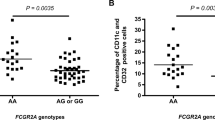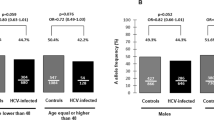Abstract
HIV-1 induces activation of complement through the classical and lectin pathways. However, the virus incorporates several membrane-bound or soluble regulators of complement activation (RCA) that inactivate complement. HIV-1 can also use the complement receptors (CRs) for complement-mediated antibody-dependent enhancement of infection (Ć-ADE). We hypothesize that hypofunctional polymorphisms in RCA or CRs may protect from HIV-1 infection. For this purpose, 139 SNPs located in 19 RCA and CRs genes were genotyped in a population of 201 Spanish HIV-1-exposed seronegative individuals (HESN) and 250 HIV-1-infected patients. Two SNPs were associated with infection susceptibility, rs1567190 in CR2 (odds ratio (OR)=2.27, P=1 × 10−4) and rs2842704 in C4BPA (OR=2.11, P=2 × 10−4). To replicate this finding, we analyzed a cohort of Italian, sexually HESN individuals. Although not significant (P=0.25, OR=1.57), similar genotypic proportions were obtained for the CR2 marker rs1567190. The results of the two association analyses were combined through a random effect meta-analysis, with a significant P-value of 2.6x10−5 (OR=2.07). Furthermore, we found that the protective CR2 genotype is correlated with lower levels CR2 mRNA as well as differences in the ratio of the long and short CR2 isoforms.
This is a preview of subscription content, access via your institution
Access options
Subscribe to this journal
Receive 6 digital issues and online access to articles
$119.00 per year
only $19.83 per issue
Buy this article
- Purchase on Springer Link
- Instant access to full article PDF
Prices may be subject to local taxes which are calculated during checkout



Similar content being viewed by others
References
Thielens NM, Tacnet-Delorme P, Arlaud GJ . Interaction of C1q and mannan-binding lectin with viruses. Immunobiology 2002; 205: 563–574.
Prohaszka Z, Hidvegi T, Ujhelyi E, Stoiber H, Dierich MP, Susal C et al. Interaction of complement and specific antibodies with the external glycoprotein 120 of HIV-1. Immunology 1995; 85: 184–189.
Ji X, Gewurz H, Spear GT . Mannose binding lectin (MBL) and HIV. Mol Immunol 2005; 42: 145–152.
Stoiber H, Clivio A, Dierich MP . Role of complement in HIV infection. Annu Rev Immunol 1997; 15: 649–674.
Banki Z, Stoiber H, Dierich MP . HIV and human complement: inefficient virolysis and effective adherence. Immunol Lett 2005; 97: 209–214.
Tortorella D, Gewurz BE, Furman MH, Schust DJ, Ploegh HL . Viral subversion of the immune system. Annu Rev Immunol 2000; 18: 861–926.
Saifuddin M, Hedayati T, Atkinson JP, Holguin MH, Parker CJ, Spear GT . Human immunodeficiency virus type 1 incorporates both glycosyl phosphatidylinositol-anchored CD55 and CD59 and integral membrane CD46 at levels that protect from complement-mediated destruction. J Gen Virol 1997; 78 (Pt 8): 1907–1911.
Montefiori DC, Cornell RJ, Zhou JY, Zhou JT, Hirsch VM, Johnson PR . Complement control proteins, CD46, CD55, and CD59, as common surface constituents of human and simian immunodeficiency viruses and possible targets for vaccine protection. Virology 1994; 205: 82–92.
Schmitz J, Zimmer JP, Kluxen B, Aries S, Bogel M, Gigli I et al. Antibody-dependent complement-mediated cytotoxicity in sera from patients with HIV-1 infection is controlled by CD55 and CD59. J Clin Invest 1995; 96: 1520–1526.
Saifuddin M, Parker CJ, Peeples ME, Gorny MK, Zolla-Pazner S, Ghassemi M et al. Role of virion-associated glycosylphosphatidylinositol-linked proteins CD55 and CD59 in complement resistance of cell line-derived and primary isolates of HIV-1. J Exp Med 1995; 182: 501–509.
Stoiber H, Schneider R, Janatova J, Dierich MP . Human complement proteins C3b, C4b, factor H and properdin react with specific sites in gp120 and gp41, the envelope proteins of HIV-1. Immunobiology 1995; 193: 98–113.
Stoiber H, Pinter C, Siccardi AG, Clivio A, Dierich MP . Efficient destruction of human immunodeficiency virus in human serum by inhibiting the protective action of complement factor H and decay accelerating factor (DAF, CD55). J Exp Med 1996; 183: 307–310.
Haapasalo K, Vuopio J, Syrjanen J, Suvilehto J, Massinen S, Karppelin M et al. Acquisition of complement factor H is important for pathogenesis of Streptococcus pyogenes infections: evidence from bacterial in vitro survival and human genetic association. J Immunol 2012; 188: 426–435.
Rodriguez de Cordoba S, Esparza-Gordillo J, Goicoechea de Jorge E, Lopez-Trascasa M, Sanchez-Corral P . The human complement factor H: functional roles, genetic variations and disease associations. Mol Immunol 2004; 41: 355–367.
Wilflingseder D, Banki Z, Garcia E, Pruenster M, Pfister G, Muellauer B et al. IgG opsonization of HIV impedes provirus formation in and infection of dendritic cells and subsequent long-term transfer to T cells. J Immunol 2007; 178: 7840–7848.
Takada A, Kawaoka Y . Antibody-dependent enhancement of viral infection: molecular mechanisms and in vivo implications. Rev Med Virol 2003; 13: 387–398.
Willey S, Aasa-Chapman MM, O'Farrell S, Pellegrino P, Williams I, Weiss RA et al. Extensive complement-dependent enhancement of HIV-1 by autologous non-neutralising antibodies at early stages of infection. Retrovirology 2011; 8: 16.
Frank MM . CD21 deficiency, complement, and the development of common variable immunodeficiency. J Allergy Clin Immunol 2012; 129: 811–813.
Asokan R, Hua J, Young KA, Gould HJ, Hannan JP, Kraus DM et al. Characterization of human complement receptor type 2 (CR2/CD21) as a receptor for IFN-alpha: a potential role in systemic lupus erythematosus. J Immunol 2006; 177: 383–394.
Asokan R, Banda NK, Szakonyi G, Chen XS, Holers VM . Human complement receptor 2 (CR2/CD21) as a receptor for DNA: implications for its roles in the immune response and the pathogenesis of systemic lupus erythematosus (SLE). Mol Immunol 2013; 53: 99–110.
Forthal DN, Gabriel EE, Wang A, Landucci G, Phan TB . Association of Fcgamma receptor IIIa genotype with the rate of HIV infection after gp120 vaccination. Blood 2012; 120: 2836–2842.
Huber G, Banki Z, Lengauer S, Stoiber H . Emerging role for complement in HIV infection. Curr Opin HIV AIDS 2011; 6: 419–426.
Lund O, Hansen J, Soorensen AM, Mosekilde E, Nielsen JO, Hansen JE . Increased adhesion as a mechanism of antibody-dependent and antibody-independent complement-mediated enhancement of human immunodeficiency virus infection. J Virol 1995; 69: 2393–2400.
Fust G . Enhancing antibodies in HIV infection. Parasitology 1997; 115 (Suppl): S127–S140.
Douglas KB, Windels DC, Zhao J, Gadeliya AV, Wu H, Kaufman KM et al. Complement receptor 2 polymorphisms associated with systemic lupus erythematosus modulate alternative splicing. Genes Immun 2009; 10: 457–469.
Wu H, Boackle SA, Hanvivadhanakul P, Ulgiati D, Grossman JM, Lee Y et al. Association of a common complement receptor 2 haplotype with increased risk of systemic lupus erythematosus. Proc Natl Acad Sci USA 2007; 104: 3961–3966.
Avirutnan P, Hauhart RE, Somnuke P, Blom AM, Diamond MS, Atkinson JP . Binding of flavivirus nonstructural protein NS1 to C4b binding protein modulates complement activation. J Immunol 2011; 187: 424–433.
Ermert D, Weckel A, Agarwal V, Frick IM, Bjorck L, Blom AM . Binding of complement inhibitor C4b-binding protein to a highly virulent Streptococcus pyogenes M1 strain is mediated by protein H and enhances adhesion to and invasion of endothelial cells. J Biol Chem 2013; 288: 32172–32183.
Kirjavainen V, Jarva H, Biedzka-Sarek M, Blom AM, Skurnik M, Meri S . Yersinia enterocolitica serum resistance proteins YadA and ail bind the complement regulator C4b-binding protein. PLoS Pathog 2008; 4: e1000140.
Castiblanco-Valencia MM, Fraga TR, Silva LB, Monaris D, Abreu PA, Strobel S et al. Leptospiral immunoglobulin-like proteins interact with human complement regulators factor H, FHL-1, FHR-1, and C4BP. J Infect Dis 2012; 205: 995–1004.
Ram S, Cullinane M, Blom AM, Gulati S, McQuillen DP, Monks BG et al. Binding of C4b-binding protein to porin: a molecular mechanism of serum resistance of Neisseria gonorrhoeae. J Exp Med 2001; 193: 281–295.
Sironi M, Biasin M, Cagliani R, Forni D, De Luca M, Saulle I et al. A common polymorphism in TLR3 confers natural resistance to HIV-1 infection. J Immunol 2012; 188: 818–823.
Fish EN . The X-files in immunity: sex-based differences predispose immune responses. Nat Rev Immunol 2008; 8: 737–744.
Pennell LM, Galligan CL, Fish EN . Sex affects immunity. J Autoimmun 2012; 38: J282–J291.
Marcovina SM, Zoppo A, Vigano-D'Angelo S, Di Cola G, D'Angelo A . Determination of serum levels of complement component C4b-binding protein: influence of age and inflammation. Int J Clin Lab Res 1991; 21: 171–175.
Comp PC, Thurnau GR, Welsh J, Esmon CT . Functional and immunologic protein S levels are decreased during pregnancy. Blood 1986; 68: 881–885.
Melissari E, Kakkar VV . The effects of oestrogen administration on the plasma free protein S and C4b-binding protein. Thromb Res 1988; 49: 489–495.
Davila S, Wright VJ, Khor CC, Sim KS, Binder A, Breunis WB et al. Genome-wide association study identifies variants in the CFH region associated with host susceptibility to meningococcal disease. Nat Genet 2010; 42: 772–776.
Pastor AF, Rodrigues Moura L, Neto JW, Nascimento EJ, Calzavara-Silva CE, Gomes AL et al. Complement factor H gene (CFH) polymorphisms C-257T, G257A and haplotypes are associated with protection against severe dengue phenotype, possible related with high CFH expression. Hum Immunol 2013; 74: 1225–1230.
Hu W, Yu Q, Hu N, Byrd D, Amet T, Shikuma C et al. A high-affinity inhibitor of human CD59 enhances complement-mediated virolysis of HIV-1: implications for treatment of HIV-1/AIDS. J Immunol 2010; 184: 359–368.
Nyholt DR . A simple correction for multiple testing for single-nucleotide polymorphisms in linkage disequilibrium with each other. Am J Hum Genet 2004; 74: 765–769.
Acknowledgements
This work was supported by Spanish Health Ministry [PI021476, PI051778 and PI10/01232 to JF, JAP and ACar]; Instituto de Salud Carlos III-RETIC [RD06/006 to JAP]; Fundació Marató TV3 [020730 and 020732 to JF and ACar]; Junta de Andalucía [PI-0335/2009 to ACar]; Fundación Progreso y Salud of the Consejería de Salud de la Junta de Andalucía [AI-0021 to JAP]; and Universidad de Jaen [UJA2013/10/03 to ACar].
Author information
Authors and Affiliations
Corresponding author
Ethics declarations
Competing interests
The authors declare no conflict of interest.
Additional information
Supplementary Information accompanies this paper on Genes and Immunity website
Supplementary information
Rights and permissions
About this article
Cite this article
Herrero, R., Real, L., Rivero-Juárez, A. et al. Association of complement receptor 2 polymorphisms with innate resistance to HIV-1 infection. Genes Immun 16, 134–141 (2015). https://doi.org/10.1038/gene.2014.71
Received:
Revised:
Accepted:
Published:
Issue Date:
DOI: https://doi.org/10.1038/gene.2014.71



